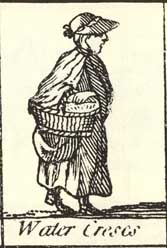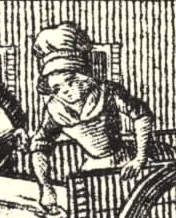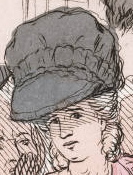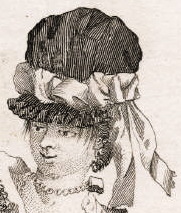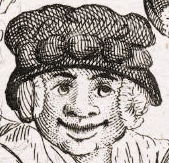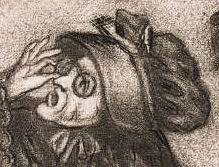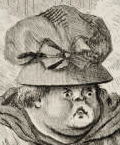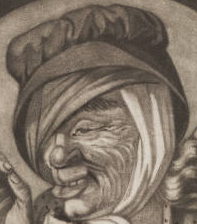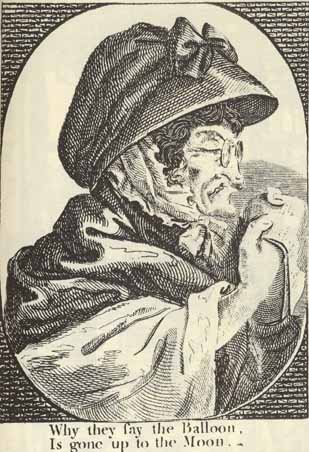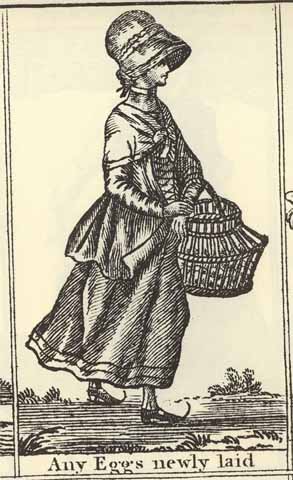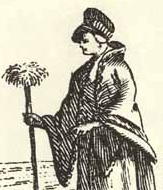“Here we behold a hat, there a bonnet…”*
Bonnets in the 18th Century
by Sue Felshin
Last modified 3 Jan 2025
Copyright © 2008–2025 Sue Felshin, All Rights Reserved
Contents
- What is a bonnet?
- Change Over Time
- Use
- Design Features
- Size | Brim shape | Caul shape | Color | Materials | Trim | Strings
- Safety Note
- Documentation
- Note on Images
- Footnotes
Women, are you tired of wearing a straw hat everywhere you go? Let's look at an alternative: the bonnet. While not as commonly worn as straw hats, we find bonnets just as widely worn, by women of every class and in plain and fancy styles. A bonnet is warmer than a hat, especially in rain or snow, and there's nothing like it for keeping your cloak hood in place. Depending on the shape, it may be better than a hat at keeping the sun out of your eyes. On the other hand, a bonnet can be unpleasant on a hot day, it restricts your view more than a hat does, and depending on the style, it restricts your hearing as well—maybe that's why we find that although bonnets were quite common in the 18th century, they didn't have the ubiquity of straw hats.
What is a bonnet?
While an exact definition remains elusive, in general we may say that an 18th century bonnet is an item of headwear consisting of two parts, a soft caul and a stiff brim which is wider toward the front than the back (and frequently narrowing to nothing at all in back). Although size and shape varied, the most common sort of bonnet had a slightly downward pointing brim of a moderate size that blocks the sun in front and leaves part or all of the ears exposed.
Change Over Time
Overall: Bonnets started to gain in popularity just as hoods become less common. That's not too surprising since the two types of headgear have much in common in terms of being warm and providing protection from bad weather. (These “hoods” were detached hoods, possibly with capes but not connected to cloaks, e.g., MFA 99.664.19.) Textual mentions of bonnets appear as early as the 1730s. Artwork with bonnets is rare until the 1770s. Although the fashionable shape changed over time, bonnets remained popular for another century.
Early 18th century: Bonnets may have developed from straw hats. The earliest artwork of a bonnet (Elisabeth Oberbüchler, 1732, Germany) is straw, as are two early references in The Pennsylvania Gazette ("plat bonnet", 1732, and "platt bonnet", 1740).
1760s–1780s: If we surmise that country people and poor people tended to wear old-fashioned bonnets, then we can start to see some trends in bonnet styles from the 1760s through the 1780s. Earlier bonnets tended to have a deep brim, either in a conical shape as in The Marquess of Granby aiding a sick soldier, 1765, and The young mendicant, 1776, or like a overgrown baseball cap brim as in The Rival Milleners, and Water Cress, undated, or somewhere in between, as in Pot Fair. Cambridge., 1777 (lefthand bonnet). As the 1770s progress, we start to see more bonnets with a shallow brim and set vertically on the head, and also a style with a tiny visorlike brim as in An old macaroni miss-led. But see Miss Tipapin Going For All Nine, 1778?, for a fairly late bonnet worn over high hair that retains the overgrown-baseball-cap style of brim. Cauls, naturally enough, grow larger as hairstyles grow larger, starting small as in The Marquess of Granby aiding a sick soldier, 1765, gaining a slight pompadour shape as in The Rival Milleners, 1772, mushrooming up into a puff as in An old macaroni miss-led, 1772 and then ballooning as in The lover's disguise, 1776?.
Post-18th century: Bonnet shapes change considerably in the 19th century, acquiring brims that flare upward and outward in the early 19th century ("Jane Austen period") and then turning into deep and tubular "poke bonnets". See Edinburgh Lacewoman, 1784 for a rare example of a flaring brim in the 18th century, and see The Silver Age for an almost mid-19th century shape, although this may be due to the child wearing an oversized bonnet that doesn't fit her correctly.
Use
Documentation shows that women wore bonnets in largely the same circumstances as hats: mostly outdoors, for protection from the elements. As with a hat, a bonnet was typically worn over a cap. Experimental archaeology (also known as “trying and seeing”) reveals that bonnets have one particular feature that hats don't have: Because they have no brim in back, you can wear a bonnet under the hood of a cloak. The bonnet holds the hood in place. It keeps it from falling backward off your head or forward over your eyes. Has it ever driven you crazy that when you wear a cloak with a hood, and you turn your head, the hood stays put and you find yourself looking at the inside of the hood? Well, when you wear a bonnet under a hood, it makes the hood turn with your head and the bonnet. It's very handy!
Design Features
Size
The typical RevWar bonnet has a fairly small brim compared to Regency and Civil War era bonnets, but size does range a fair amount. Commonly, the brim covers up to about half the ear. See the safety note, below!
Brim shape:
The typical Revolutionary War era brim is downward pointing. However, not all are. Brim shape varies from a circle with smaller circle (“bite”) taken out of it to a long strip with only a slight curve.
- The circle-with-circular-bite shapes (similar to a modern baseball cap brim, but larger), yield a 1760s–1770s shape.
- See: Water Cress, Scater, The Rival Milleners, Fording the Brook, A ladies maid purchasing a leek, An evenings invitation, with a wink from the bagnio, A call to the unconverted (lefthand bonnet), Is this my daughter Ann, A Society of Patriotic Ladies, at Edenton in North Carolina (foreground bonnet), Pot Fair. Cambridge. (righthand bonnet), Miss Tipapin Going For All Nine, and The liberty of the subject. These brims are typically paired with small cauls for common folk (Water Cress, Fording the Brook, A call to the unconverted (lefthand bonnet), Is this my daughter Ann) and large cauls for women in fashionable dress (A ladies maid purchasing a leek, An evenings invitation, with a wink from the bagnio, Miss Tipapin Going For All Nine).
- Visor-like shape:
- An extreme version of the circle-with-bite shape with a small and nearly flat brim rather like a visor can be seen in An old macaroni miss-led, The pretty mantua maker, and The man of business. These brims are paired with cauls shaped like fairly large round puffs.
- Conical shape:
- See The Marquess of Granby aiding a sick soldier, The invitation, The young mendicant, and A Market Girl Holding A Mallard Duck.
- A narrow strip-like shape is first seen in 1773 and remains a common style through rest of the decade:
- The brim has a slight curve that creates a slight flare, and is set fairly vertically so as to encircle the head. See Pea-Cart, The Abusive Fruitwoman, A call to the unconverted (righthand bonnet), The slip, or, Miss, willing to be in the ton, The lover's disguise, and Lord No--h, in the suds.
- A rare style is a wide strip set vertically.
- See Walton's The Silver Age (possibly oversized for the wearer), Heyday! Is this my Daughter Anne! in versions from 1773 and 1779, and The old maids morning visit, or, The calash lady's. Any Eggs newly laid is a very unusual example of a wide strip brim set somewhere between horizontally and vertically.
Caul shape:
Caul shapes, as cut, appear to vary from an arch to a bowed arch to a circle. If a circle, then the brim meets itself in back. An arch-shaped caul, with a casing through the straight bottom edge and long strings in the casing, yields a bonnet that can be stored flat. A bowed arch or circle yields a smaller, neater caul. Some bonnets have smooth stiff cauls. Are these the oft-mentioned “jockey bonnets”? I don't know, and I don't know how those cauls are constructed. Are some cauls made of a strip sewn into a loop and then tightly gathered along one edge like the pleated circle at the back of a cloak hood? I'm not sure, although the bonnet in Catchpenny #152 (Any Eggs newly laid) kind of looks that way.
- Small, close-fitting caul:
- See The Marquess of Granby aiding a sick soldier (possibly a very small flattened puff), Watercress, Scater, Is this my daughter Ann, and Mrs. Lane.
- Flattened puff:
- See Fording the Brook, The Abusive Fruitwoman, Heyday! Is this my Daughter Anne! in versions from 1773 and 1779, Pot Fair. Cambridge. (lefthand bonnet), The young mendicant, and A Market Girl Holding A Mallard Duck.
- Pompadour:
- See CWF 1993-335 artifact, The Rival Milleners, and Buying a Mop.
- Round puff:
- See An old macaroni miss-led, The pretty mantua maker, A ladies maid purchasing a leek, An evenings invitation, with a wink from the bagnio, The man of business, and Pot Fair. Cambridge. (righthand bonnet).
- Giant puff:
- These cauls have trim around the caul itself, which I surmise is to control the shape of the caul, which might otherwise collapse or become disordered. See The lover's disguise, The slip, or, Miss, willing to be in the ton, and A lady in waiting. The additional trim in The slip, or, Miss, willing to be in the ton appears to be a ribbon tying the bonnet onto the wearer's head—the bonnet appears to be too large for her head.
- Stiffened(?), flat-topped cone covered with rows of trim:
- See The invitation and A Society of Patriotic Ladies, at Edenton in North Carolina (background bonnet).
- Divided caul, lengthwise or crosswise:
- See A Society of Patriotic Ladies, at Edenton in North Carolina (foreground bonnet) and Catchpenny 140 ("… moon … balloon").
Color
Based on writings, black was by far the most common color, white a very distant second, then very few blue, even fewer green and brown, and lastly various rare examples. Nancy Watt's study of the Pennsylvania Gazette found about five times as many black bonnets as white bonnets, and hardly any bonnets of other colors.
Materials
Based on writings, taffeta was the most common, with some examples of peelong (satin), velvet, certain wool fabrics such as stuff and camlet, and even a tiny number in linen. Brims could be stiffened with pasteboard ("chip"), whalebone, or (possibly) buckram. Most brims show no visible stiffening and are presumably stiffened with chip or buckram, but for a creased brim that must be stiffened with chip or buckram, see The young mendicant. For examples stiffened with whalebone, see CWF 1993-335, The invitation, The Rival Milleners, and Miss Palmer.
Trim
The most common trim appears to be a gathered strip of self fabric, sometimes with a bow in the front. Here are just a few examples:
CWF 1993-335, The Rival Milleners, Fording the Brook, An old macaroni miss-led, The Abusive Fruitwoman, Water Cress, Pea-Cart.
Other trims include a bow at the front, back, or both, and fancier trims. An uncommon possibility is no trim. Most artworks are black and white so it's hard to tell if the trim is self fabric, matching ribbon, or contrasting trim. Silk taffeta will hold an edge well if pinked so makes a good material for self fabric trim. Some runaway ads mention bonnets with lace (not many). The bonnet in Sandby's Mrs. Lane appears to be trimmed with narrow lace or cord and with ruched or gathered or textured ribbon.
Trim along the front edge is not common but is occasionally seen, for example:
The liberty of the subject, An old macaroni miss-led, Mrs. Lane.
Strings
Strings (ties) are not generally visible in art. Bonnets generally stay on well without being tied, and you can tuck ties up in the brim until needed in very cold or windy weather.
Safety Note
A bonnet will affect your perception of sound. Depending on how far down over your ears your bonnet comes, it may merely dampen echoes, or may change your perception of where sounds come from, or may even eliminate sounds from some directions almost entirely. Test your bonnet, and if it affects your hearing significantly, then be careful when wearing it, especially when crossing streets!
I find that any bonnet that covers half the ears or less doesn't impair hearing badly, but “your mileage may vary”. My bonnet comes about halfway down my ears. While there is an interesting sound change (compare how certain room shapes, like concert halls, can reflect sound differently from normal), my hearing is not impaired to any noticeable degree. My bonnet brim allows me to see straight ahead and (mostly) to the sides but cuts off all upward vision. This is great for keeping sun out of eyes and still lets me see ground level traffic, but does limit visibility noticeably.
Documentation
Artifacts
- Woman's hat [sic], black silk, 1770–1780, England. Colonial Williamsburg Foundation, Acc. No. 1993-335. Black ribbed silk, boned brim with baleen stays. The bonnet was on display at the DeWitt Wallace's Language of Clothing exhibit and it is pictured on p. 9 of What Clothes Reveal (Linda Baumgarten, CWF with Yale University Press, 2002). The shape of the brim and caul is very typical. The trim is very typical as well, with the exception of the bow in back, which is uncommon but not rare. The baleen stiffening is uncommon, but not rare.
Art
- A view in St Paul's Churchyard on a windy day, 1740. The Guildhall Art Gallery, p5438014, London Metropolitan Archives. Sayer, Robert, publisher. Very rare image of an early bonnet. This may be a silk-covered bonnet with a smooth, stiffened caul, or it may be a straw bonnet—compare the shape of Germanic(?) straw bonnets (see Elisabeth Oberbüchler). The trim between brim and caul is of a typical form with a bow in front, and is ribbon or fabric of a medium tone. Either there is light-colored trim along the front of the brim, or the bonnet is straw and the edge has a distinctive braiding pattern. Because of the way the wind catches the bonnet, it is difficult to tell whether it has a upward-flaring brim or a typical downward pointing brim.
- Edward Penny, The Marquess of Granby aiding a sick soldier, 1765. Reproduced in: Johnson, E.D.H. Paintings of the British Social Scene: From Hogarth to Sickert. Reissue edition: Weidenfeld & Nicolson Ltd, 2000, ISBN 0297789090. Very conical brim shape with tiny caul. There is a bow at the front where the caul joins the brim, but it is impossible to tell whether there is any trim around the join.
- The RIVAL MILLENERS. John Collet pinx.t Rob.t Laurie fecit. Publish'd as the Act directs, 2.d March 1772. Printed for Rob.t Sayer, N.o 53 in Fleet Street, London. Colonial Williamsburg Foundation, Acc. No. 1955-125. Black bonnet, probably silk, possibly satin. Brim lined with a lighter-colored fabric. Trimmed with self-fabric or matching ribbon. Bow in front at join of brim and caul. Ribbon ends drape over the proper left side of the brim, with the ends finished with three teeth. The flattened shape across the front of the brim, bordered by two vertical lines, may indicate that this bonnet is stiffened with whalebone.
- Grimm pinx. Dickenson fecit. Fording the Brook. Published according to the Act 1 Decr 1772. Printed for John Bowles, at No. 13 in Cornhill. New York Public Library, Satyr p.194. Black bonnet trimmed with self-fabric or matching ribbon. Fairly typical shape of brim and caul, although in a somewhat squat form, probably to match the squat form of the wearer, as part of the satire. A ribbon end drapes over the proper right side of the brim, and probably another end over the proper left side.
- An old macaroni miss-led. [London] : Pub. accor. to act, by MDarly, Strand, April 26th 1772. Lewis Walpole Library, Yale University, 772.04.26.02. Unusually small and flat brim, almost like a modern baseball cap, with a comparatively large and puffy caul. The trim along the brim–caul join is in large poufs attached only between the poufs; unusually, there is a bow at the side (proper left) rather than the front. Ends trail down from the bow, finished with three teeth. There is ruched or gathered trim along the front edge of the bonnet (compare Sandby's Mrs. Lane), in self-fabric or matching-color ribbon.
- The pretty mantua maker. Pub according to Act Jany. 1 1772 by MDarly Strand. Lewis Walpole Library, Yale University, 772.1.1.3.1. Compare An old macaroni miss-led. Although some of the details of trim are different, the bonnets, mantles, gowns, and poses are so similar that one print is probably copied from the other (or both from some other artwork). In this case, the gathered trim along the top front edge of the brim is a lighter color than the bonnet.
- A ladies maid purchasing a leek. Brandoin pinxt. ; Caldwall sculp. [London?: s.n. 1772]. Lewis Walpole Library, Yale University, 772.03.01.01.2. Smallish brim with largish caul. The most notable feature is the odd trim (well, and the highly suggestive imagery). Perhaps there are wide strings that wrap around the back of the head and somehow fasten on top, but that seems an odd way of fastening a bonnet, and it is not seen in other artworks. There is additional similar trim that doesn't wrap around.
- The Abusive Fruitwoman. Pubd 25th Feby 1773 by J.R. Smith. National Portrait Gallery, NPG D47053; also Library of Congress, PC 3 - 1773 - Abusive fruitwoman c-P&P(A size). Black bonnet, probably silk, trimmed with self fabric or matching-color ribbon in a typical format of trim around the brim–caul join with a bow in front. The trim has a twisted appearance. This may be an artifact of the drawing style, or the trim may be applied in an unusual matter. This bonnet is on the large size, but suits the wearer well. This is the earliest image displaying a strip-shaped brim, and the shape is only marginally more like a strip than a baseball-cap-like crescent.
- Heyday! Is this my Daughter Anne! F.E. Adams invt. et fecit. Publish'd Decr. 6 1773 by John Bowles No. 13 in Cornhill. Black bonnet, probably silk, trimmed with self fabric or matching-color ribbon in a typical format of trim around the brim–caul join with a bow in front. The trim is flat, which is unusual. Typical brim in the strip-shaped style with vertical orientation. Despite using a nearly mid-19c-like shape, the brim still slants down slightly (taking into account that the mother's head is tipped back). What is a country woman doing in an ermine(???)-edged short cloak?! Compare a very similar version of this print from 1779.
- An evenings invitation, with a wink from the bagnio. [London]: Printed for Carington Bowles, Map & Printseller, No. 69 in St. Paul's Church Yard, London, published as the act directs, [ca. January, 1773]. Lewis Walpole Library, Yale University, 773.01.00.02+. White bonnet with pink trim along brim–caul join in two rows of poufs and with cockade at front. Smallish brim, tallish caul.
- The invitation. London : Printed for Robt. Sayer & J. Bennet, No. 53 Fleet Street, as the act directs, 22d July 1774. Lewis Walpole Library, Yale University, 774.07.22.01+. White bonnet, probably silk, with brim stiffened with whalebone. The brim is untrimmed. The conical caul ends in a flat segment, and the conical portion is trimmed with two wide rows of ruching with the lower row slightly overlapping the upper row.
- A call to the unconverted Cole fecit. London : Publish'd April 15, 1774, by W. Humphry, St. Martin's Lane, [1774]. Lewis Walpole Library, Yale University, 774.04.15.01+. Two women wear bonnets. The bonnet on the left is black or a medium color, of indeterminate material, and has a moderately unusual conical brim (with slight belling). The brim–caul join is trimmed with a plain band with a bow in the front. The bonnet on the right is black and is of a similar overall shape and with the same trim, but with a less flared brim. Both women wear their bonnets over slightly old-fashioned lappet caps. Three other women appear in the print; one wears a hat (at a very fashionable near-vertical slant, and over a fashionable hairstyle), one only a cap, and one (at lower left, nursing a baby) is unclear but may wear a handkerchief over a cap.
- The man of business. [London] : Pubd. June 1st 1774, by MDarly, 39 Strand, [1774]. Lewis Walpole Library, Yale University, 774.06.01.01+. Of seven women, one wears a bonnet, five others wear hats, and one wears only a cap. The bonnet is probably black and has a small and rather horizontal and visor-like brim. The caul is fairly tall. The brim–caul join is trimmed with a plain band of ribbon; as it is fairly vertical, it must be largely over the caul rather than the nearly horizontal brim.
- Is this my daughter Ann J.H. Grim invt. et delin. ; Watson sculp.. London : Printed for S. Sledge, Printseller in Henrietta Street, Covent Garden, as the act directs, 27 June 1774. Lewis Walpole Library, Yale University, 774.06.27.01+. Brown bonnet. The trim along the brim–caul join is purple? ribbon, lightly gathered or ruched, with a bow in the back. The brim is very flat and the shape of the caul is almost like a fedora. The mother wears a black handkerchief or other fabric under the bonnet, wrapped around her head and tied under her chin-this wrapping is too thick to be bonnet strings. The colors may be an invention of a later colorist. Note that the gown bodice is green while the skirts are pinkish, suggesting that the colorist did not understand what the mother is wearing. While the green part might be a jacket, it would be a very unusual jacket with no skirts whatsoever.
- Dawe, Philip (attributed to). A SOCIETY of PATRIOTIC LADIES, at EDENTON in NORTH CAROLINA. London, Printed for R. Sayer & J. Bennett, N.o 53 Fleet Street, as the Act directs 25 March 1775. Colonial Williamsburg Foundation, 1960-132. Contains two bonnets (also six hats, one small, fancy cap, and one head wrap). Appears to be a satirical print despite the naive commentary on the CW page—"delicate touch", forsooth. The bonnet in back is black with medium-tone trim along the front of the brim and in four rows across the caul. The caul ends in a squared-off back. This bonnet somewhat resembles the bonnet in The invitation, in the shape of the caul. The bonnet in front is black or a dark color with trim around the brim–caul join in a neatly gathered style (probably with two or more aligned rows of gathering threads) and has a bow in back. The caul has deep indentations running from front to back; is this the style called "mushmelon"? The bonnets may be exaggerated in form for satirical purposes, but it is likely that bonnets of the general shape existed, perhaps with lower or less-indented cauls.
- Henry Walton, The Silver Age, c. 1776–7. More tubular shape than most though still doesn't approach a 19th century poke bonnet. This bonnet comes unusually far down on the head, but it may be that the bonnet is sized for an adult or for someone with their hair dressed higher on the head. Unusually, the girl wears her bonnet over her cloak hood, perhaps because the bonnet is too large for the hood.
- The lover's disguise. London : Printed for and sold by Carington Bowles, No.69 in St. Pauls Church Yard, [1776?]. Lewis Walpole Library, Yale University, 778.01.01.05. Black bonnet with narrow brim. In addition to the ruched or gather trim along the brim–caul join, another bands of trim goes around the caul a few inches higher. This may help to control the shape of the very large caul and may provide some stiffening. Two ends are visible in back. These may be ends of the trim, or may be the ends of strings in a casing at the back, used to cinch up the back of the bonnet.
- Pot Fair. Cambridge. Bunbury & Bretherton. Publish'd 25.th June 1777. Lewis Walpole Library, Yale University, 777.06.25.01.02+. Two bonnets, both black or possibly a medium color. The bonnet on the righthand woman is very similar to the one in A ladies maid purchasing a leek. The bonnet on the woman to her left is fairly similar to the bonnet in Fording the Brook, although this bonnet has a more conical brim. Both bonnets are trimmed only with a bow in front. Strings at the back of the righthand bonnet probably belong to the bonnet, but might be part of an otherwise invisible cap. A woman in the foreground wears only a cap while a woman at the extreme left wears a straw hat with a sheer handkerchief tied over it.
- The old maids morning visit, or, The calash lady's. [London] : Pubd. M Darly 39 Strand, Marh 11, 1777. Lewis Walpole Library, Yale University, 777.03.11.01+. Bonnet on floor at left; a mother cat and kittens appear to have made it their home. It is difficult to tell much about the bonnet, but it has a large brim of a rather straight shape, it is either black or of a medium to dark color, and it is trimmed along the brim–caul join with white or light-colored ribbon tacked down every so often to form loose poufs, and there is a bow at center front.
- The young mendicant Josiah Boydell, pinxit.; V. Green, ... fecit. [London] : Published March 1st 1776, by J. Boydell, engraver in Cheapside, London, [1776]. Lewis Walpole Library, Yale University, 776.03.01.04. Light-colored bonnet with a rather conical brim—compare The Marquess of Granby aiding a sick soldier. The brim is creased in several places, showing damage and wear. The brim–caul join is trimmed with a narrow ribbon tied at the back, possibly a little off to the side. She does not appear to wear a cap, and the white ribbon strings under her neck are probably a very rare example of visible bonnet strings.
- The slip, or, Miss, willing to be in the ton. London : Printed for Ino. Smith, No.35, Cheapside as the Act directs, 11th Septr. 1777. Lewis Walpole Library, Yale University, 777.09.11.01+. Narrow, fairly straight and vertical brim. Both brim and caul are very large. There is a ribbon around the caul, a little above the brim–caul join and tied with a bow in front. It appears that this ribbon is what cinches the overlarge bonnet and holds it in place. Trim extends beyond the front edge of the brim; it appears to be black lace, but might be a gathered strip or a fancy weave of ribbon.
- Miss Tipapin Going For All Nine. From the Original Picture by John Collett in the possession of Carington Bowles. Printed for & Sold by Carington Bowles, at his Map & Print Warehouse, No. 69 in St. Pauls Church Yard, London. Publish'd as the Act directs [after January 1, 1778?]. Lewis Walpole Library, Yale University, 778.01.01.05. The woman at the right wears a black silk bonnet, possibly satin, sized to fit over her large hairstyle. The brim–caul join is trimmed with a wide band of closely ruched fabric or ribbon, with a bow in front and another bow in back. Two other women wear hats with or without caps, and one wears only a cap.
- Heyday! Is this my Daughter Anne! F.E. Adams invt. et fecit. London : Publish'd as the Act directs, 11th October 1779 by Robert Wilkinson ..., [1779]. See the nearly identical print of the same name from 1773. In this 1779 version, the mother's mantle seems over-fine for a country woman, but less so than the ermine-edged version in the 1773 print.
- The liberty of the subject. [London] : Publish'd Octr. 15th. 1779 by W. Humphrey ..., [1779]. Lewis Walpole Library, Yale University, 779.10.15.01+. Woman at left wears bonnet of very typical color (black), shape, and trim. Narrow trim at brim–caul join is ruched. Two other women wear only caps and/or handkerchiefs.
- Zoffany, Johann The Watercress Girl, 1780. On the Web at World Art News. Brown silk bonnet, paler brown lining, large collapsed (?) caul.
- Zoffany, Johann. The Flower Girl, circa 1780. On the Web at World Art News. Large, tall black bonnet, suitable for the high hair of the 1780s, although the girl's hair is worn loose. (The bonnet may be an artist's prop.) Huge bow of self-fabric at center front at the join between brim and caul. Complex, ruched(?) trim around the top of the brim, broadening from center front to cover up to half of the depth of the brim. Other than the height and trim, the bonnet is quite typical in shape.
- Smith, John Raphael. A lady in waiting. [London] : Printed for & sold by Carington Bowles, at his Map & Print Warehouse, No. 69 in St. Pauls Church Yard, London. Publish'd as the Act directs, [ca. 2 September 1780]. Lewis Walpole Library, Yale University, 780.09.02.01+. This huge bonnet suits the large hairstyles of the 1780s. It is black silk with a very straight, vertical, narrow brim, with a narrow band of ruched or gathered trim either along or on top of the front of the brim, a wider band of ruched or gathered trim along the brim–caul join and completely covering any part of the brim not covered by the first trim, and with a third piece of trim higher up on the caul arranged in poufs or vertical rolls, with a bow in front. The top of the caul falls into complex folds. It is possible that the row of trim in the middle of the caul is used to hold the bonnet on; compare The slip, or, Miss, willing to be in the ton. If so, the trim must be a double layer with the outer layer pre-sewn into the poufs or rolls.
- An ENGLISH MAN of WAR, taking a FRENCH PRIVATEER. Printed for & Sold by CARINGTON BOWLES, at his Map & Print Warehouse, N.o 69 in S.t Pauls Church Yard, London. Published as the Act directs, 4 June, 1781. Colonial Williamsburg, Acc. No. 1962-290. Probably a bonnet rather than a hat, but it is impossible to be sure due to the quantity of trim on the caul/crown. Also at the Lewis Walpole Library Digital Collection, 781.06.00.01+ with different coloration and a different interpretation of the swag at her proper right of her bonnet or hat.
- Smith, John Raphael. Lord No--h, in the suds (Lord North, in the suds). [London] : Pub. by T. Evans Oxford Street Mch. 27, 1782 London, [1782]. Lewis Walpole Library, Yale University, 782.03.27.01. Typical bonnet of the style that has a narrow, fairly vertical brim. Black, and trimmed around the brim–caul join in moderately large poufs. There are three other women; one wears a cap, a handkerchief over the cap, and a hat over the handkerchief; two others wear only caps.
- Allan, David. Edinburgh Lacewoman. 1784. On the Web at Before the Clearances: 17th and 18th Century Scottish Costume (scroll down or search for the artwork name to find it). The woman is a Scottish Lowlander. This is a very unusual example of a bonnet with the brim flaring outward, although it flares only slightly upward; see The Purim Festival in the Portuguese Synagogue, for another possible example. If you greatly lighten the image, it appears that there is an ungathered band of trim around the brim–caul join with a small bow or cockade in front.
- Russell, John. A Market Girl Holding A Mallard Duck, 1787. Blue bonnet. No apparent trim around the brim–caul join, but there is a bow in front. Despite the late date, this bonnet resembles some earlier bonnets, e.g., the shape matches The Marquess of Granby aiding a sick soldier although that bonnet is somewhat larger, and even more closely matches the bonnet in The young mendicant.
- The Fortune Teller P. Mercier pinxt. Robt. Laurie fecit. London, Printed for Robt. Sayer No. 53 Fleet Street, as the Act directs 2 Jany 1789. The Lewis Walpole Library, Yale University, 789.01.02.01. On the Web at the Lewis Walpole Library and at A Catalogue of 18th-Century British Mezzotint Satires in North American Collections. White or light-colored bonnet. Visible lines radiating across brim may indicate that this bonnet's brim is boned like the Colonial Williamsburg artifact (see photo in What Clothes Reveal by Linda Baumgarten, 2002).
- [Home from market], 1790. Large, downward-facing, conical brim. Caul of uncertain size covered in many large poufs of trim, or possibly the poufs are the caul itself (attached to an interior lining to retain shape?).
- Snuff and Twopenny, ca. 1793? In A Collection of Drolleries, 1770-1797, Folio 75 C697 770. Lewis Walpole Library, Yale University, 793.0.19. Typical bonnet shape. Untrimmed, which is fairly uncommon. Apparently black.
- Paul Sandby, Mrs. Lane. Date not available. Image not available on the Web. Appears in Sandby Drawings at Windsor Castle, by A.P. Oppé; Phaidon Press, Ltd, London, 1947. Also appears as the frontispiece in Patricia Baines' Spinning Wheels, Spinners and Spinning (republished by Robin & Russ). Typical shape but on the small side, with a tiny caul, and with trim on top of the front edge of the brim as well as along the brim–caul join, plus an additional narrow lace trim extending beyond the front of the brim.
- Paul Sandby, Mrs. Lane. Date not available. Image not available on the Web. Appears in Sandby Drawings at Windsor Castle, by A.P. Oppé; Phaidon Press, Ltd, London, 1947. Also appears as the frontispiece in Patricia Baines' Spinning Wheels, Spinners and Spinning (republished by Robin & Russ). Typical shape but on the small side, with a tiny caul, and with trim on top of the front edge of the brim as well as along the brim–caul join, plus an additional narrow lace trim extending beyond the front of the brim.
- Reynolds, Joshua. Miss Palmer. White silk bonnet with a wide band of trim, probably self-fabric, along the brim–caul join. It may be permanently applied, or it may be tied on. There may be a narrow lace edging applied to the edge of the trim. There appears to be some sort of sheer trim on top of or along the front edge of the brim, possibly lace. Faintly visible lines radiating across the brim indicate that this bonnet's brim is boned like CWF 1993-335. The style of the portrait is unusual—Miss Palmer's shoulders are dropped and her neck falls slightly forward in a mid-19th century fashion—yet the hairstyle is consistent with the tall hair of the 1770s.
- Russell, John. The Blind Beggar and His Granddaughter. The Bowes Museum. On the Web at ArtUK. A modest-sized bonnet, black silk lined with white silk. There is some rather nice trim around the edge between the brim and caul. It has taken a bit of a beating, so maybe this very poor girl has bought it second hand. Or it could be be an artist's prop; it's so hard to tell in these cases.
-
The Catchpenny Prints collection contains
eight bonnets of good variety.
See #s 24,
107, 120, 138,
140, 152,
184, and 196. Some
are good examples; some are European (Dutch) or perhaps really hats or
caps. (Bowles and Carver. Old English Cuts and Illustrations
for Artists and Craftspeople. Dover Books, ISBN:
0–486–22569–0.) The Catchpenny prints in the Dover
reprints are unfortunately undated.
- Water Cress in print #196 contains what I think of as the stereotypical Revolutionary War era everyday bonnet, with a fair-sized brim with a slightly downward slope, cut back sharply enough to reveal about half of the ears, with simple trim around the brim–caul join. In this case there is also a bow in back, or we may be seeing the bow of the strings in the casing that cinch up the caul in back. It appears to be worn over a lappet cap. It probably dates to the 1760s, or else shows a woman wearing an old-fashioned style.
- The bonnet in Scater in #184 is similar and is worn over a dormeuse cap. It may be slightly later than Water Cress since the dormeuse cap is a later fashion (although it overlapped with lappet caps) and since the hairstyle is slightly higher. It may date to the 1770s, or even to the 1780s if the woman is wearing a restrained version of 1780s big hair. Compare A ladies maid purchasing a leek, 1772.
- Catchpenny #120, Buying a Mop shows a bonnet with a somewhat unusual shape of brim in that it may flare upward slightly and curves down over the ears. Or the curve over the ears may be the cap, in which case the brim would be in a moderately common very small and flat style; compare The pretty mantua maker, 1773. The caul is in a pompadour style; compare The Rival Milleners, 1772. This bonnet may date to the early 1770s.
- Catchpenny #107, Pea-Cart, and Catchpenny #152, Any Eggs newly laid, show similar bonnets that appear to be sized for late 1770s high hair transitioning toward 1780s big hair. Compare The Abusive Fruitwoman, 1773, A call to the unconverted , 1774, and The slip, or, Miss, willing to be in the ton, 1777.
- Catchpenny #140 (Why they say the Balloon / Is gone up to the Moon.) shows a large bonnet, likely sized for 1780s big hair. The caul falls into horizontal folds, somewhat like a calash. Perhaps this is the unidentified "mushmelon" style, or perhaps the mushmelon style has its indentations traveling from front to back as in A Society of Patriotic Ladies, at Edenton in North Carolina, 1775.
- Catchpennies #24 and #138 show unusual bonnets. The bonnet in Dutch Skaters in #24 may be a Dutch style or possibly the unidentified style called a "jockey bonnet". The bonnet in Botany in #138 has an unusual button(?) at the top of the caul, in a manner reminiscent of a Scotch bonnet.
For additional post-Revolutionary War bonnets, see 18th Century Notebook : 18th Century Women's Bonnets.
For a Germanic (?) style of bonnet, see:
- Pesne, Antoine. Elisabeth Oberbüchler, 1732. Herzog Anton Ulrich Museum (HAUM), Braunschweig, Germany. A protestant refugee from Salzburg. On the Web at La Couturière Parisienne. This is the earliest bonnet image known to me. This bonnet is made of straw in a continuous shape suggesting a single braided piece rather than a separate brim and caul, which is an efficient means of construction for a straw bonnet. An applied piece of straw braid forms a simple trim. This and two following images picture Continental European bonnets, all of the same continuous form and with a deep, nearly tubular brim, suggesting but not proving that all are straw.
- Chodowiecki, Daniel Nikolaus. A Fair in Berlin, 1774. Reproduced in Aileen Ribeiro's Dress in Eighteenth Century Europe, 2002, p. 56, and on the cover of the Burnley & Trowbridge catalog (detail). Little detail can be seen, but the bonnet appears to be nearly identical to the one in Elisabeth Oberbüchler, 1732.
- The Purim Festival in the Portuguese Synagogue, Amsterdam reproduced in The Jewish Calendar 2001: With Illustrations from the Collection of the Jewish Museum, New York, March. Basset (French 1700s). After L.F. du Bourg (Dutch, 1693–1775), 18th century. Engraving, JM 20–67. Photo: John Parnell.
Writings
Newspapers contain many written references, some mentioning color, fabric, lining color, lining fabric, size, condition, or style. Most mentions are in ads for runaways, and some are for stolen goods or goods for sale. Unless otherwise noted, these bonnets are from The Pennsylvania Gazette:
- 1732, “a new plat bonnet lined with red silk which she stole in New-Castle fair” (American Weekly Mercury)
- 1740, “a Platt Bonnet lined with light red Silk”
- 1741, “an old black silk Bonnet, pretty much torn”
- 1751, “a laced Bonnet”, “Just imported from London, in the Myrtilla, … silk bonnets”
- 1759, “just imported from London … shade bonnets plain and fettled”
- 1760, “a new black Silk persian Bonnet”, “black Sattin Bonnet”
- 1761, “Check Linen Bonnet”, “a black Sattin Bonnet, lined with white”, “a new black Silk Bonnet”, “from London … black Sattin Hats & Bonnetts” (Boston News-Letter)
- 1763, “a black Peeling Bonnet, with Pasteboard and Gimp round it”, “a black Silk Bonnet”, “a black Silk Fly Bonnet”, “light blue Bonnet”, “an old black Bonnet”
- 1764, “one black Peeling Bonnet, lined with Taffety”, “black bonnet”, “Bonnets proper for Widows and other Ladies, are made in the genteelest Manner, and sold by Anne and Elizabeth Cummings” (Boston Gazette), “with no other Token of Mourning than a black Bonnet, Gloves, Ribbons and Handkerchief” (Boston Gazette)
- 1766, “a striped linen bonnet”, “a Bath Bonnett, covered with black Taffety, lined with dyed Linen”
- 1767, “a Bonnet”, “a white Bonnet”, “took her Mistress's Bonnet”, “one black bonnet, with green lining”
- 1768, “a black sattin bonnet, with whalebone all round”, “an old black bonnet”
- 1769, “a new black taffety bonnet, lined with blue persian”
- 1770, “one black peelong bonnet, trimmed with the same”
- 1771, “an old green whalebone bonnet”
- 1772, “an old changeable silk bonnet, lined with blue silk, and tied with a white ribbon”, “a linen check bonnet”, “black sattin laced bonnet”, “a black silk bonnet”, “Now selling … Dunstable and chip hats and bonnets”
- 1773, “a blue silk bonnet”
- 1774, “a black bonnet” (Boston Evening Post), “an old black silk bonnet”, “a black Silk Bonnet” (Virginia Gazette)
- 1775, “A new black pelong bonnet, with black lace around it”, “a new black taffety bonnet”, “a pale blue silk bonnet”, “2 bonnets, one black, the other white”, “a black bonnet”, “an Irish servant maid … she has no bonnet on, as she has commonly a ribbon round her head”
- 1776, “reddish coloured worsted bonnet”, “one white halfworn peeling bonnet”, “a black alamode bonnet with lace”, “a cloth coloured pelong bonnet, lined with pale blue mantua”, “two Irish servant women … each a black bonnet”
- 1777, “black bonnet with blue lining”, “black silk bonnet with ribbon round the crown”, “a black silk bonnet with white silk lining” (The Penna. Evening Post), “and without a bonnet or hat”
- 1778, “one black mode bonnet lined with white”, “old fashioned black silk bonnet”, “green flowered satin bonnet … about half worn”
- 1779, “one black silk bonnet with a drawed crown”
- 1785, “a black, silk bonnet, with white lining”, “an oil cloth hat or bonnet”
- 1786, “a black silk bonnet almost new”
- 1790, “an old black bonnet”
Inventories are another good source of documentation, for example:
- 1761, Mary Nutter, Portsmouth, £3713, “… a Bonnet and a … Velvet hood”
- 1762, Margaret Chambers, Portsmouth, £10972, “…Velvet Bonnet and handkerchief”
- 1768, Elizabeth Amsden, Deerfield, “… 1 cambelt Riding hood, 1 black Capuchine Cloak, 2 Red Broadcloth Do, 1 Velvet bunnet … 1 Velvet hood”
Note on Images
Images from the Lewis Walpole Library Digital Collection are courtesy of The Lewis Walpole Library, Yale University, used with permission granted to the author.
Catchpenny images are from The Catchpenny Prints: 163 Popular Engravings from the Eighteenth Century, originally published by Bowles and Carver, Dover Publications, Inc., New York, 1970. Images are used with permission: "Up to ten illustrations from this book may be reproduced on any one project or in any single publication, free and without special permission."
Footnotes
* From The general index as to twenty-seven volumes of the London Magazine, or the Gentleman's Monthly Intelligencer, Vol. XL, for the year 1771, page 308.
